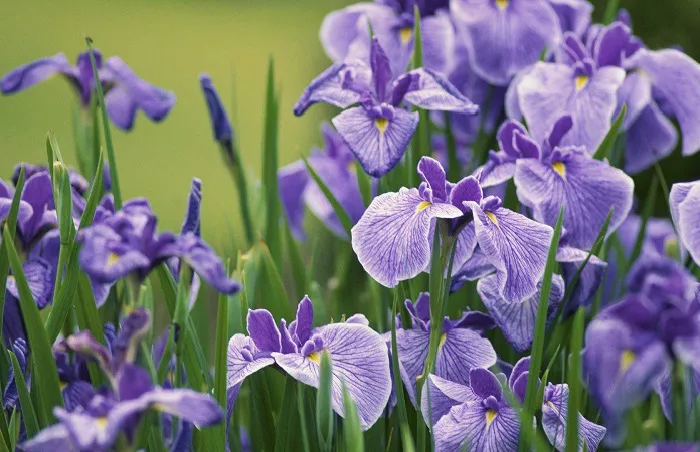Iris flowers are a gardener’s delight with their striking beauty and variety. Knowing when they bloom helps us plan our gardens better. Let’s dive into the world of irises and discover the perfect months for their blossoms.
What Month Do Iris Bloom?
Generally, most irises bloom in late spring to early summer. This is the period when the weather is warm enough for them to show off their beautiful flowers. However, some early-blooming varieties can start flowering in late winter or early spring, while others might extend their bloom into mid-summer.
Understanding Iris Varieties and Their Bloom Patterns
There are many different types of irises, each with its own blooming characteristics. The most common type is the bearded iris, which is known for its fuzzy “beard” on the lower petals. Bearded irises usually bloom from late April to June. This makes them a great addition to gardens that need a splash of color in the spring. Another popular variety is the Siberian iris, which prefers cooler climates. It typically blooms in late May to early June. The Dutch iris, on the other hand, is a bulbous variety that blooms in late spring. Its tall, slender stems and bright flowers make it a favorite for cut flower arrangements.
Factors Affecting Iris Bloom Time
Several factors can influence when irises bloom. One important factor is the climate. In warmer regions, irises may bloom earlier than in cooler areas. For example, in southern climates, bearded irises might start flowering in late March or early April. In contrast, in northern climates, they may not bloom until late May or June. Soil conditions also play a role.
Irises prefer well-drained soil with a neutral to slightly acidic pH. If the soil is too wet or too acidic, it can delay blooming or even prevent flowers from forming. Another factor is the amount of sunlight. Irises need at least six hours of direct sunlight per day to bloom well. If they are planted in a shady spot, they may not flower as much or as early as they should.
Tips for Maximizing Iris Bloom
To get the best blooms from your irises, there are a few things you can do. First, choose the right location. Plant your irises in a spot that gets plenty of sunlight and has well-drained soil. Avoid planting them in low-lying areas where water can collect. Second, prepare the soil properly. Add organic matter such as compost or well-rotted manure to improve soil texture and fertility. This will help your irises grow strong and healthy. Third, water your irises correctly.
They need regular watering during the growing season, but be careful not to overwater them. Overwatering can lead to root rot and other problems. Finally, fertilize your irises. Use a balanced fertilizer in early spring to give them a boost. Avoid using high-nitrogen fertilizers, as these can promote leaf growth at the expense of flowers.
Iris Bloom Care and Maintenance
Once your irises start blooming, it’s important to take good care of them. Deadheading, or removing spent flowers, can help encourage more blooms. This is especially important for bearded irises, which can produce multiple flowers on a single stem. After the blooming season is over, cut back the flower stalks to the base of the plant. This will help the plant focus its energy on producing new growth for next year. It’s also a good idea to divide your irises every three to five years. This will help prevent overcrowding and ensure that your irises continue to bloom well.
Extending the Iris Bloom Season
If you want to enjoy iris blooms for a longer period, there are a few strategies you can use. One option is to plant a mix of early, mid-season, and late-blooming varieties. This will give you a continuous display of flowers from late winter to mid-summer. Another idea is to plant irises in different locations around your garden. By placing them in areas with slightly different microclimates, you can stagger their bloom times. For example, planting some irises in a sunny spot and others in a slightly shaded area can help extend the overall blooming period.
Iris Bloom Problems and Solutions
Sometimes, irises may not bloom as expected. There are a few common problems that can affect their flowering. One issue is overcrowding. If irises are planted too close together, they may not have enough space to grow and bloom properly. In this case, dividing the plants can help. Another problem is pests and diseases. Iris borers are a common pest that can damage the leaves and prevent flowering. To control iris borers, you can use insecticidal soap or remove the larvae by hand. Diseases such as leaf spot and root rot can also affect iris blooms. To prevent these problems, make sure your irises are planted in well-drained soil and avoid overwatering.
Conclusion
Irises are a wonderful addition to any garden, with their beautiful blooms and easy-care nature. By understanding their bloom time and taking proper care of them, you can enjoy their flowers for many years. Whether you have a small garden or a large landscape, there is an iris variety that will fit perfectly. So, plan your garden with irises in mind and get ready to be amazed by their stunning display.I hope this article has given you a better understanding of when irises bloom and how to care for them. Happy gardening!


